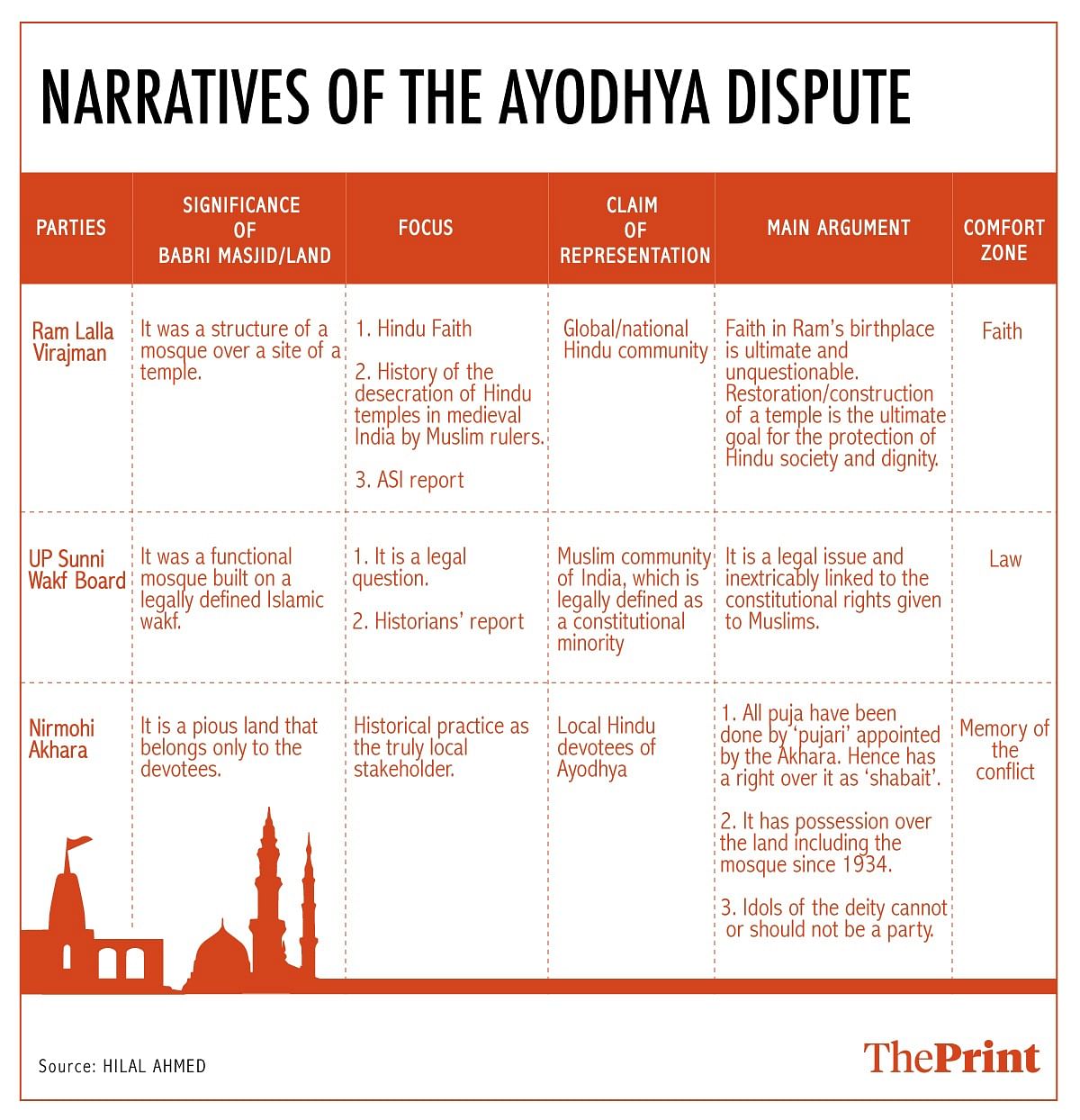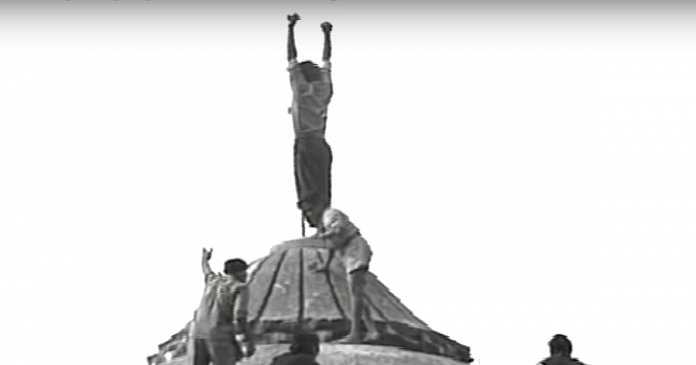The Ayodhya case that the Supreme Court is hearing is being falsely and simplistically projected as a Hindu-Muslim conflict. It is not. It is a typical property dispute in which land, a built structure, and the possession of land are being fought over by three parties.
Each of the three parties — the Sunni Wakf Board, the Nirmohi Akhara and the Ram Lalla Virajman — have fought the case on very distinct arguments of law, memory and faith.
The Vishva Hindu Parishad-supported Ram Lalla Virajman makes a faith-based argument that Hindus believe in the unquestionable divinity of Lord Ram and that the court must respect the sentiments of the Hindu community. The Nirmohi Akhara relies on the memory of the conflict to argue that it has an ultimate right over the land. And the UP Sunni Wakf Board evokes the centrality of law to make a case for the land (not the mosque).
Also read: All will respect Supreme Court decision on Ayodhya, says UP Chief Minister Yogi Adityanath
Ram Lalla Virajman’s case: faith + archaeology – history
The Wakf Board and the Ram Lalla Virajman may officially claim to represent the Hindus and Muslims of India, but the Nirmohi Akhara’s presence as a legitimate stakeholder in the case undermines this obvious communalisation of the Ayodhya dispute. (It is, in fact, ironic that the Allahabad High Court in its judgment eventually accepted the Wakf Board as the ‘representatives of Muslim interests’).
The legal history of the conflict also confirms that the VHP’s self-representation as the sole spokesperson of the Hindus is factually wrong. The VHP did not have legal standing in the Ayodhya case before 1989. It filed a petition on behalf of the deity, Ram, before the Allahabad High Court only on 23 October 1989, claiming that “the entire premises (disputed site and the area around it)…belong to the…deity therefore defendants should be prohibited from interfering in the …construction of new temple building”. (A.G. Noorani, 2003. The Babri Masjid Question 1528-2003: A Matter of National Honour. Vol. 2, Delhi: Tulika, p. 217). This is what is known as the Ram Lalla Virajman.
This legal intervention had three outcomes. First, it legitimised the VHP’s claim as a stakeholder in the title suit. Second, the Hindutva demand to have a grand Ram Mandir found a legal recognition. It was now possible to raise the issue of the construction of a new temple on the site of the demolished Babri Masjid within the framework of the title suit.
But more importantly, the VHP was now able to legalise its faith-centric argument in favour of a Ram Mandir.
However, the Ram Lalla Virajman doesn’t rely solely on Hindu faith for its legal argument. The ASI report on Ayodhya excavations from 2003 forms the outer layer of its argument. It claims that the archaeological findings prove there was a Hindu religious structure beneath the Babri Masjid. Hence, it claims, the Hindu belief that a temple of Ram was demolished to build the Babri Masjid is a ‘scientific’ fact.
However, the Ram Lalla Virajman and those that share its position remain critical of the Historians’ Report to the Nation (1991), which argues that the existence of Ram Mandir is a myth.
Also read: The unusual and quirky questions Supreme Court asked during Ayodhya hearing
Nirmohi Akhara’s case: Faith + collective memory – Hindutva
The Nirmohi Akhara rejects the Sunni Wakf Board’s land ownership claim completely. But it does not go with the Ram Lalla Virajman for the sake of Hindu unity either. During the recent court proceedings, the lawyer representing the Nirmohi Akhara criticised the Ram Lalla Virajman for transforming the idols of Ram into a legal party in the Ayodhya dispute.
The Nirmohi Akhara makes three central arguments. First, the members of the sect are the real worshippers of Ram. Second, all pujas have been done by the pujari appointed by the Nirmohi Akhara in the past. Hence, they have an inalienable right over this pious land as ‘shabait’ (devotee). Third, the Nirmohi Akhara has had possession over the land, including the mosque, since 1934. For this reason, its ownership claim must be recognised.
This is, of course, a faith-based argument. However, unlike the Ram Lalla Virajman’s position, faith in Ram is not presented as an absolute truth. Rather, the Nirmohi Akhara invokes the collective memory associated with the land to justify its claims.
In this sense, the Nirmohi Akhara challenges the Vishva Hindu Parishad’s grand Hindu politics on two counts. First, it opposes the VHP’s claims on historical grounds, arguing that it has been the main contender since 1934. Second, it also turns down the Hindu nationalist project of the Ram Lalla Virajman by highlighting the localised nature of the conflict.
Also read: What about Babri Masjid? How land became more important than the mosque in Ayodhya
UP Sunni Wakf Board: Law + history – archaeology
The UP Sunni Wakf Board is the only party that formally claims to represent Muslim interests. But it does not argue for reclaiming the mosque or its reconstruction. Nor does it adhere to its old position — once a mosque always a mosque — as the main legal argument.
The Sunni Wakf Board, instead, concentrates on the land on which the Babri Masjid once stood and its legal status as an Islamic wakf property. The emphasis on land saves the Wakf Board from two possible challenges.

First, the Muslim politics of the Babri Masjid was not about taking over the structure of the mosque for regular prayers. Muslim leaders were keen to use Babri Masjid as a case to protect other historic mosques across India that are targeted by the radical Hindutva groups. (Hindu Temples: What Happened to Them, a 1990 book by Arun Shourie, Sita Ram Goel, Jay Dubashi, Harsh Narain and Ram Swarup, contains a list of 2,000 mosques that it says stand on top of demolished temples).
The Places of Worship (Special Provisions) Act, 1991, was an outcome of this politically strategic call by Hindutva groups. Since the Babri Masjid was treated as an exception in this Act, the Muslim elite lost interest in the Babri Masjid issue after its demolition in 1992. That’s the reason why the Sunni Wakf Board focuses entirely on the land, and that too, in an overtly legal sense.
The second challenge is very specific. The Sunni Wakf Board always presents the Historians’ Report as scientific evidence — partly because this report substantiates its legal-constitutional position, and partly because it gives historical legitimacy to Babri Masjid’s wakf status.
This adherence to scientific history, nevertheless, is very selective. The Sunni Wakf Board has been very uncomfortable with the court-appointed archaeological excavation in Ayodhya, although it has not yet offered any systematic critique of the ASI report. The lawyers of the Sunni Wakf Board have argued that the ASI report was filled with “palpable and inherent infirmities and inconsistencies”.
Also read: The erasure of the Babri Masjid actually began six years before its demolition
It is clear that each party identifies its own comfort zone and makes conscious efforts to redefine the ownership of land into a conflict of civilisations between Hinduism and Islam. The courtroom, in this schema, has been transformed into a theatre, where different narratives of conflict are enacted in a way to sustain the conflict.
The author is a Fellow at the Nantes Institute of Advanced Studies, France (2019-2020) and Associate Professor, CSDS, New Delhi. Views are personal.




The Sunni board is fighting a battle for the inconsequential abandoned mosque, which controversy has done irreparable damage to the interest of 18Cr Muslims of India who are today victims of polarisation, hate politics and biases tarding their every effort for a peaceful life.It is this controversy that changed the political demography of our secular nation. Whether they win or loose this battle, the generations of Muslims will loose the goodwill of Hindu brothers that is so vital for their progress.No minority can sustain without the goodwill of majority which the Sunni board is determined to erase in its intoxication as saviours of Muslims. The greatest service they could do is to pull out and say that the Muslims gift the land,and let it be a contest between the two Hindu parties. If the personal law board thinks it is protecting future claims of other mosques, again they are fooling themselves and the ignorant lot of Muslims as that will take another half a century. By then the community will be ruined.The need of the the day for Muslims is education , economic well being and good will of majority.The first step to reverse the damage done so far by Babri controversy is to immediately pull out of the case and announce magnanimously that Muslims gift it .If you fail the Muslims of India and coming generations would pay a price that you would be responsible.
The fact remains that the property is owned by the Muslims. If you go back in history to retake property where will it end? No ones property will be safe. All of this because of a fairy tale about someone that does not or did not exist! Insanity!
Cultural context of India must always remain Hindu, as 80% of population is Hindu and a few % hinduism derived religions. Other religions are free to exist minus conversions. There are many countries with official religions , Sri Lanka-Buddhist , China -Communist, Pak/Bangladesh -Islam , Burma – Buddhist , Mexico -Catholic , Almost all south American countries are official catholic , All middle east countries are official Islamic , Where is a Official Hindu Country on this planet ? Declare India an Official Hindu country and the pesky issues with cultural context will be over.
(Ref: https://en.wikipedia.org/wiki/State_religion )
Very true ! ; this should be done.
The title of this article suggests “intellectual-ish convolutions” which is the hiding place for a certain kind of authors. Babri case is a plain example of Hindus’ superiority complex and the consequent high-handedness which should not be allowed to go unchallenged by the law of the land. There is ABSOLUTELY NO PROOF that lord Ram was born in the exact premises where Babri mosque once stood. Period.
I agree totally. Sentiment and belief have no place in law. The law should be followed and this is a property dispute.
there is enough proof of the temple to predate controversial structure as per archaeological evidence. Rest all your point are whataboutery, that place had a temple and main temple of that city dedicated to diety. There is surely a reason for that. People palways perceived as the place of janmbhoomi.
And secondly use your real arabic name
Sorry to disappoint you, I am an Indian Hindu who belives in constitutional democracy and the rule of law, not mobocracy. In law there is no scope for sentiment.